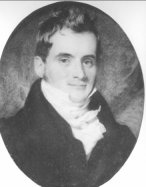![]() COLONEL
JOHN
PRINCE
COLONEL
JOHN
PRINCE![]()
FAMILY HISTORY OF DWYER LAYE FAMILY CONT'D
![]() COLONEL
JOHN
PRINCE
COLONEL
JOHN
PRINCE![]()
FAMILY HISTORY OF DWYER LAYE FAMILY CONT'D

***Ross, Robert Budd, Landmarks of Detroit; a history of the city, by Robert B. Ross and George B. Catlín. Rev. by Clarence W. [!] Burton: 1898. see p 403.
Palmer, Friend, Early days in Detroit; papers written by General Friend Palmer, of Detroit, being his personal reminiscences of important events and descriptions of the city for over eighty years. [c1906] See pp 587 and 1006.
Wing, Talcott Enoch, ed. History of Monroe County, Michigan ...Publication date: 1890. See pp 207, 210, 211
|
|
OTHER PAGES OF THIS SITE:
| LAYE FAMILY UK | Connected by Marriages or Reference |
|
EMILY LAYE Dau of Major Francis Fenwick Laye, grand daughter of Lt. General Francis Laye |
DIXON BROWN Northumberland UK , Margaret Brown married Lt. General Francis Laye 1803. |
|
AIREY of Northumberland Lt. General Francis Laye married Mary Airey 1803 Also GILPIN, GOODEN, MULCASTER, BEDFORD (BEDFORDE), BARKUS, LAYE |
GILLMAN of Portsmouth LT COL BERTIE CUNYNGHAME DWYER married Beryl Maud Gillman c 1907. |
| BARNES, BUTLER, CHAPMAN ANDERSON NICHOLSON Northumberland From Laye/Airey/Barnes Line | GUY BURGESS Spy for KGB LT COL BERTIE CUNYNGHAME's sister-in-law, -Evelyn Gillman.,was the mother of this double agent. |
|
CLAVERINGS and FENWICKS Northumberland, From Laye/Airey/Barnes Line |
Who Muurdered Nurse Florence Nightingale Shore My book project |
|
GREY Northumberland Laye/Airey/Barnes/Clavering/ |
CASHER Family of Beryl Maud Gillman - A Casher did the research, and I am merely posting it for him. |
|
GILPIN Northumberland Northumberland, From Laye/Airey/Barnes Line |
FLORENCE NIGHTINGALE: SMITHS Her maternal side: For studying the Shores or Nightingale Studies |
| BEDFORDE BEDFORD Durham, UK From Laye/Airey Line |
FLORENCE NIGHTINGALE: THE SHORE FAMILY Norton Hall, Sheffield of Norton Hall. |
| General Thomas Peard Dwyer Detailed Career |
FLORENCE NIGHTINGALE LINKS For Nightingale Studies |
| Lt. General Francis Laye Major General Joseph Henry Laye I Major General Joseph Henry Laye II Detailed Careers |
PRINCE Essex, Ontario Tied to ways: GG Grandmother Emily Laye married John Prince, grandson of Col John Prince, and her dau, Mary Anne Dwyer married the Hon. Albert Prince, M.P- the son of Col. Prince. (Yes, that's right). |
| DWYER |
HON COLONEL JOHN PRINCE, M.P. A character. Reputed to be illegitimate son of an actress and William IV, notorious for killing American prisoner's of war in the Battle of Windsor. Detroiters put a price on his head. Popular in Windsor. |
|
LT COL BERTIE CUNYNGHAME DWYER Bertie won Grand National in 1887. "Bertie Dwyer, an English boy of 14 . . . did the fastest time of the race, the only rider to break the two minute barrier with 1 minute 58.6 seconds . . . [A] truly remarkable effort for any rider let alone a 14 year old" (23 The Cresta Run 1885-1985). |
LINKS GENEALOGICAL / MILITARY Reference Only. |
| INSPECTOR WM BLENNERHASSETT DWYER Detroit Police Inspector Very incomplete | |
| KENNY County Kerry, Ireland Also, DWYER, TENT (BROWNE), COURTHROPE, HOARE | DEAN PITT Connected in two way. General J.H. Laye senior married Emelia Dean-Pitt, and Ensign George Sinclair Laye married Amy Selina Nugent, dau of Charlotte Marcia Dean-Pitt. |
| BUTTERFIELD / SIMPSON AND DUCKETT LANCASHIRE and BOND | E. P. Ramsay-Laye author/feminist pen name: Isobel Massary 4 books, articles, such as "Women and Careers" in Englishwoman Review, 9, (Apr 1878) p 96 -Arguing desirability of married women having careers. |
|
Blennerhassett Kerry From Dwyer/Hoare Also CONWAY, LYNNE, CRUMPE, O'CONNOR, HOARE, DWYER |
LAYE Surname Study UK For Genealogical Reference for all Layes |
|
O'CONNOR Tralee Ireland From Dwyer/Hoare Also DWYER, BLENNERHASSETT, HOARE, DENNY, MAYNARD, BARRY, ROPER, FORREST, EDGECRUMBE, ETC |
|
|
KEENAN Detroit/ Ontario Sarah Keenan married my gg grandfather, St. Hugh Simpson Gerald Toulmin Dwyer in Detroit in 1895. |
LETTERS OF MARY AIREY LAYE Letters written by Lt. General Francis Laye's widow, pestering Lord Somerset, later Ragland, for an Ensignacy for her son. Letters to others, like Lord Hill and the Marchioness Winchester. |
| TOULMIN London and LANCASHIRE, Mary Anne Toulmin Married to General Thomas Peard Dwyer 11 Apr 1839, Old Church, Saint Pancras, London Includes: BECKETT, SIMPSON, DWYER, HARRISON, TALBOTT, | DWYER CUNYNGHAME Photo Album |
| WALSH -Meath Ireland Married to Laye Family Anne Maria Teresa WALSH married Emily Laye's father, Major Francis Fenwick Laye 28 Oct 1835 in Newbridge, Colpe Church County Meath, Ireland | CUNYNGHAME Connection is on English branch of family. Captain Robert Hoare Dwyer married Caroline Georgina Thurlow CUNYNGHAME |
| HOARE Kerry Cork Connected by Robert Dwyer, father of General Thomas Peard Dwyer marrying Mary Hoare, 1744 Tralee, Kerry. Also KENNY, DWYER, BLENNERHASSETT, BURNELL, GILPIN, NOTT, WOODCOCK, KELLEY | RAMSAY Scot. Eng India Connection is Major Francis Fenwick Laye married Elizabeth P Ramsay |
| OGLE Northumberland Laye/Airey/Barnes/Clavering/Grey | ASCENSION ISLAND Mini & partial hist of the RM commandants by Comm (General) T.P. Dwyer |
| PATERNAL ---- PASKIEWICZ Plymouth PA/Vilna and Starynki, Russia (Старынкі ). | DWYER Surname Study Detroit For Genealogical Reference for all Dwyers |
| PATERNAL ---- GRIZDIS and many other spelling Plymouth PA/Vilna | |
| PATERNAL--- MIKOLAYESKI Plymouth PA/Russia/Poland | PATERNAL ---- ZENKO Plymouth PA/Vilna, Olita |
| PATERNAL-- SINKIEWICZ or SINKCAVAGE Plymouth PA/Lithuania | PATERNAL --- RUZANTIS Plymouth PA/Suwalki |
home to Dwyer Page:layedwyer